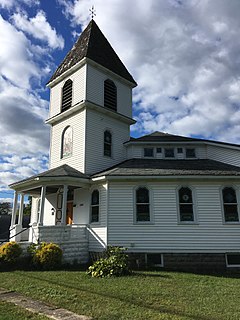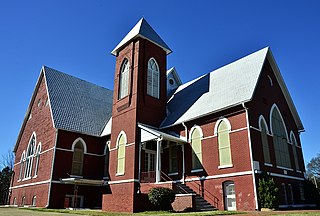
Capon Chapel, also historically known as Capon Baptist Chapel and Capon Chapel Church, is a mid-19th century United Methodist church located near to the town of Capon Bridge, West Virginia, in the United States. Capon Chapel is one of the oldest existing log churches in Hampshire County, along with Mount Bethel Church and Old Pine Church.

The Johnson Chapel Missionary Baptist Church is a historic church in Laurel, Florida. It is located at 506 Church Street. On October 8, 1997, it was added to the U.S. National Register of Historic Places.

Cedar Grove is an unincorporated community in Orange County, North Carolina, United States. It is located southeast of McDade, and northwest of Hillsborough.

The Evangelical Baptist Church is an historic church located at 23 Chapel Street, in the village of Nonantum in Newton, Massachusetts. Built in 1873 in Gothic Revival style, it was designed by noted Boston architect Charles Edward Parker, who had in 1853 designed what today is the Architects Building of the Boston Society of Architects at 52 Broad Street, Boston. Evangelical Baptist Church was added to the National Register of Historic Places on September 4, 1986.

First Baptist Church is a historic Baptist church located at Sandy Creek in Oswego County, New York. It was built in 1917–1918 and is a 1+1⁄2-story frame church with an octagonal plan and a pyramidal roof. The front of the building features a three-stage rooftop tower. The interior layout is based on the Akron plan.

Antioch Missionary Baptist Church is a historic Baptist church at 313 Robin Street in Downtown Houston, Texas. It was historically a part of the Fourth Ward. As of 2012 it was the only remaining piece of the original Fourth Ward east of Interstate 45.

Baptist Chapel Church and Cemetery is a historic Baptist church and cemetery located near Helton, Ashe County, North Carolina. It was built in 1872, and is a simple one-story frame structure, covered by weatherboards and set on a common bond brick foundation.

First Baptist Simpsonville Chapel is a historic Southern Baptist chapel at 106 Church Street in Simpsonville, South Carolina, USA.

The Provo Third Ward Chapel is a historic building located in Provo, Utah. It was listed on the National Register of Historic Places on April 2, 1979.

Union Park Congregational Church and Carpenter Chapel is a historic church building at 60 N. Ashland Blvd. on the Near West Side of Chicago, Illinois. The chapel is named after Philo Carpenter, a deacon, a co-founder of the congregation and of the Chicago Theological Seminary, and an early donor of the original church who was also a noted abolitionist and the city's first druggist. The two buildings are considered as a unit; together, they are a Chicago Landmark and an Illinois Historic Landmark and are listed on the National Register of Historic Places. The church building is currently occupied by the First Baptist Congregational Church, whose official mailing address is 1613 W. Washington Blvd. in Chicago.
Hyrum Conrad Pope was a German-born architect with important architectural works throughout the western United States and Canada. Pope was born in Fürth, Bavaria and immigrated to the United States as a teenager. He went to school at the Art Institute of Chicago where he was influenced in the Prairie School architectural style. In 1910, he opened an architectural firm with Harold W. Burton in Salt Lake City, Utah. Pope designed a variety of places of worship for many faiths, civic buildings and homes, some of which are listed on the National Register of Historic Places.
Harold William Burton was an early 20th-century architect with architectural works throughout the western United States and Canada. Burton was one of the most prolific architects of chapels, meetinghouses, tabernacles and temples for The Church of Jesus Christ of Latter-day Saints. In 1910 he opened an architectural firm with Hyrum Pope in Salt Lake City, Utah. They particularly appreciated Frank Lloyd Wright and the Prairie School architectural style. As young architects, Pope & Burton won design competitions for two of their better-known works, the Cardston Alberta and Laie Hawaii temples of the LDS Church. Burton moved to Los Angeles, California in 1927 to set up another office in the firm with Pope. After Pope unexpectedly died in 1939, Burton established a new firm with his son Douglas W. Burton. Together they continued to design many buildings, including some for the church, and in 1955 Harold Burton became the chief supervising architect for the LDS Church. One of his final works was the Oakland California Temple. Aside from places of worship, Burton designed civic buildings and homes. Many of his works exist today, some of which are listed on the National Register of Historic Places.

First Baptist Church is a historic church at 709 Martin Luther King, Jr. Street in Selma, Alabama. A historically African American Baptist church, it was built in the Gothic Revival style in 1894 and known for its association with the Civil Rights Movement. It was added to the National Register of Historic Places in 1979.

The Ward Chapel AME Church is a historic African Methodist Episcopal Church building at 319 N. 9th Street in Muskogee, Oklahoma. It was built in 1904, three years before Oklahoma achieved statehood. It was added to the National Register in 1984.

The Granite LDS Ward Chapel-Avard Fairbanks Studio is a historic building in Sandy, Utah. It was built in 1903-1905 as a meeting house for The Church of Jesus Christ of Latter-day Saints, and designed in the Romanesque Revival architectural style. It was acquired by sculptor Avard T. Fairbanks in 1966, and remodelled as his art studio. The building has been listed on the National Register of Historic Places since December 30, 2005.















